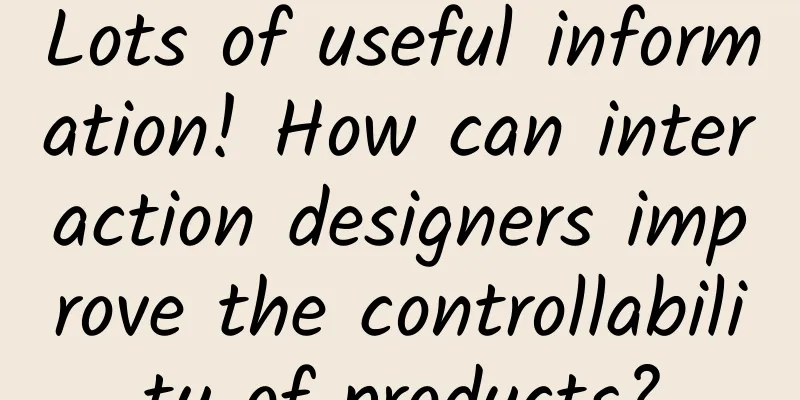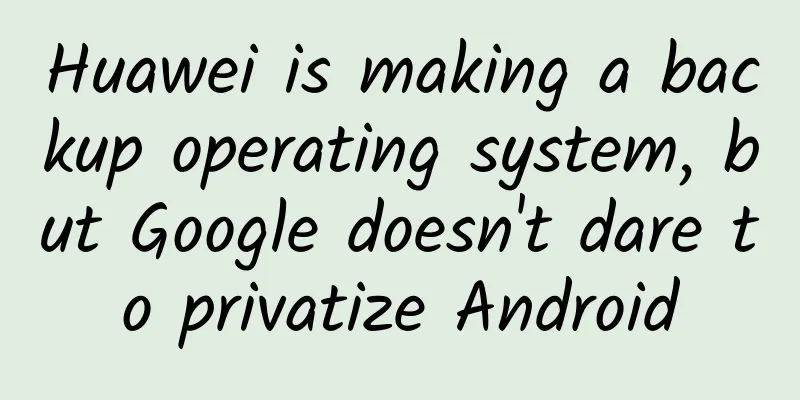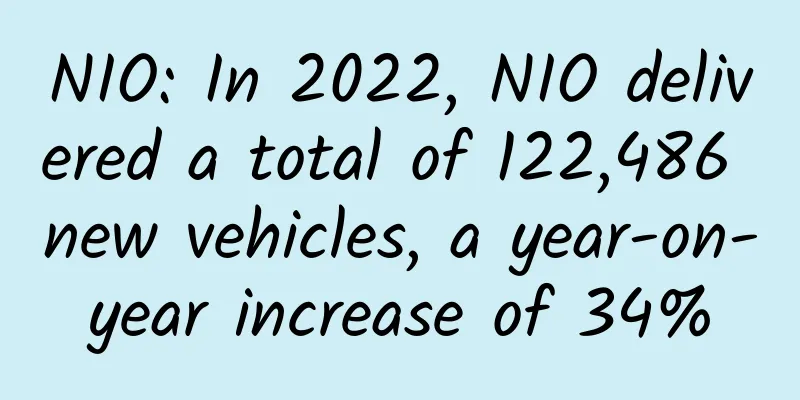Lots of useful information! How can interaction designers improve the controllability of products?

|
Interaction designers pursue the goal of providing users with the best user experience. However, in many usage scenarios, the product experience is unpredictable and cannot be taken care of using conventional design methods. It is like encountering a traffic jam when going out or encountering bad weather when traveling. When this happens (for example, there is a problem with the user's mobile network), how to comfort the user, or even further, how to prevent the user from noticing the occurrence of this situation, is a problem that designers are unanimously studying and solving. Based on the research results of psychology, using some tricks in design to "confuse" and "cheat" users, distract them, or make them think that they are not in a bad experience is one of the ways to solve this kind of problem. It's like a magic trick. The audience gets pleasure from watching and experiencing the "illusion" and "scam" created by the magician, but this does not mean that the magicians have moral problems. The same is true for designers. We are all serving users. The author of the following translation, Marli Mesibov, introduces the user's pursuit of "controllability" through cases, as well as the designers' thinking on the design and solutions that give users "controllability". Enter the translation below. Every day, when I stand at the intersection at my doorstep, I will subconsciously press the "cross the road" button, and then I have to wait for a while until the cross-road indicator lights up before I can cross the road. Finally, one day, I suddenly had an idea and did not press the "cross the road" button. After a while, the indicator light still lit up. The cross-road button that I press every day has the same result! Whether I press it or not, the traffic light will turn red and green according to the preset rhythm...
In this case, is it necessary to set up a button to cross the road? These buttons without actual functions are called "placebo buttons", and they are actually everywhere: at crosswalks, in subway stations, and on automatic thermostats. They have no actual function, but just provide users with a feeling: I can manually operate the system even in an automatic system. It sounds strange, why do we give users this feeling? Why do we deceive users? Because users always want to feel autonomous and in control! A closer look at the three different form design solutions described below can help us understand the above conclusions. These three solutions are used in an online registration form for applying to participate in a local talent show. Solution 1: A user opens a form and the cursor automatically moves to the first column of the form: Name. When the user fills in his/her name, the cursor automatically moves to Birthday, then Address. The further down the form goes, the more complex the information required to fill in becomes. The user is unsure how to answer the question in the current column, "Why do you want an account?", so he/she tries to skip to the next question. Unfortunately, the form does not allow him/her to skip questions, and he/she must write something in the current column to skip to the next question. Solution 2: The user opens the form and the cursor is automatically positioned in the first column: Name. However, this time the user has independent control and can choose whether to fill in the information in this column. The user can submit the form at any time and under any circumstances, regardless of whether he or she has completed all the options in the form. However, candidates who do not fill in the form completely will have a smaller chance of being selected to participate in the talent show. In the third scenario, the user opens the form and, in keeping with the concept of user autonomy, can skip questions as they wish (like in the second scenario), but when he submits the form, an error message appears, telling him that all options need to be filled in before the form can be submitted. Most users prefer option 3, which gives users a high degree of freedom to fill in or skip options, while ensuring that the form can be fully filled out before being submitted for review. In other words, users get the feeling of safe automation and autonomy at the same time. In this article, we will discuss why we need control, how to create this feeling, and whether placebo buttons make sense in UX design. The need for controllability Humans are born with a need for self-control. The famous psychologist Abraham Maslow's hierarchy of needs theory points out that the most basic needs of human beings are physiological needs, namely health, food and sleep. In order to meet these needs, humans need a lot of control, such as controlling the environment in which we live to get enough food; self-discipline control to avoid disease, etc. Therefore, it is not surprising that humans try to seek control over everything. Everyone has been learning to control everything in life since birth. Only when the surrounding things are under our control can we feel comfortable and safe. The control we are talking about here is very similar to the internal control that psychologists call, which was proposed by social learning theorist J. Rotter. In the process of the influence of the surrounding environment (including the psychological environment), individuals recognize the power to control their own lives, that is, everyone's awareness and orientation of the responsibility for their own behavior and behavior results. There are two types of internal control and external control. The former refers to attributing the responsibility to some internal reasons of the individual (such as ability, degree of effort, etc.), and the latter refers to attributing the responsibility or cause to factors outside the individual (such as environmental factors, luck, etc.). As an interaction designer, we try to ensure that users have a positive experience when using our products or services. This is often done by empowering users and helping them gain internal control through the tools we provide. In other words, we make users feel that they have been given more control over their operations. As Nadine Kintscher (interaction consultant at Sitback Solutions) said in the following paragraph: “Today, you can freely adjust the brightness of your screen, turn off notifications from apps, decide whether to connect to your phone’s wireless network, etc. Although these can only extend your phone’s battery life by a few minutes, they give you a sense of accomplishment: you have full control over your phone and you can adjust all the settings! (You can’t actually control your phone’s battery life!)” Kintscher's point is that "the feeling of control is much more important than the user's ability to actually control the battery life of their phone. Sensory experience and deception Interaction designers are very good at deceiving users! From Instagram to Microsoft, interaction designers have been using endless tricks to give users a better user experience! Here are a few examples. Instagram always pretends to be running smoothly When Instagram loses network connection, theoretically it cannot load new pictures and update feedback of users' "like" clicks. But in fact, Instagram smoothly shows users: I am working normally! As shown in the picture above, Instagram is designed to show users that it is running smoothly in any case. Even when there is no network, it will store the user's operation record locally and rerun the user's operation after the network is restored. For users, this is deceiving them. In fact, it is not! When the user clicks the "like" button, the system does not store and update the status in real time, and his friends do not see the update of this status. This may be called a trick. When the system is connected to the network, the "like" status will be updated quickly. The progress bar is also an illusion Whether downloading something on a PC or a Mac, we will all encounter a progress bar indicating the progress of the download. We have also experienced the long "1 minute left" moment! Obviously, the time indicated by the progress bar is different from the actual time we wait, but this does not affect designers' love for progress bars at all. A few years ago, the famous engineer John Herrman wrote an article explaining why progress bars are deceiving users. In short, download speeds are inconsistent and unpredictable. There are many factors that restrict download speeds, and the system cannot accurately calculate when the download is complete. The purpose of the progress bar is just to make users feel that the download time has shortened. This is called time design in psychology, and the progress bar is designed to make users feel that the progress is loading faster than it actually is. After a series of tests, Herrman designed the fastest-perceiving progress bar mode, but it actually deceives users: when the progress is actually loading, the progress bar moves faster, accompanied by a rolling ripple animation effect. Levels and methods of “deception” Obviously, "everyone does it" is not enough to explain why users are deceived. We live in the information age, and everyone who loves reading books and newspapers knows that various media are currently criticizing large Internet companies, such as Facebook, Google, Android, and Amazon, for hiding information from users. This concealed information includes vague personal privacy settings, and not clearly indicating to the public which institutions and individuals the user's personal data belongs to, who can track the user's location through this data, etc. Users want to know the truth so that they can make more independent decisions when using Internet products and encountering problems. When we are faced with a large amount of information and countless ambiguous options, we are often paralyzed and unable to make a choice (choice syndrome, think about the scene when you buy clothes on Taobao). In this case, information out of context becomes worthless. Going back to the example of crossing the road at the beginning of the article, suppose there is no "cross the road" button to press when waiting for the traffic light. We can only wait and lose control, which often makes us helpless and impatient, which is a bad user experience. If we find that the knob we often use to adjust the temperature in the office is actually a "placebo button" and has no function, it will make us feel that we have lost our internal control and make us more anxious. This is a very difficult balance. Whether to use "tricks" to get a good experience is something designers need to consider. Next, let us provide several solutions that do not need to confuse the facts, but provide users with a real controllable experience. Encourage high freedom of operation In the previous example, we discussed three options for filling out forms. In the third option, users are motivated by the freedom to choose the content of the form. The system does not force users to know that all options must be filled in, and users are not "cheated". This high degree of freedom can be used as a reference for other scenarios. For example, allowing online education users to freely choose to assemble a "complete course" or provide more than one way to complete a task (for example, users can click the "Finish" button to complete the task, or click the "Next Question" button on the page to complete the task) Rich control over secondary functions There’s a saying: “Let your brother decide for you what you don’t care about.” It can also be applied to experience design. It’s why banks allow users to choose their profile pictures and why we customize the pictures on our credit cards (for free). These inconsequential decisions both give users a sense of control and distract us from the issues that really require our own decisions. Skeuomorphism Simulating real-world behaviors and things in the digital world can improve the user experience of the product. Skype simulates the "pause noise" in the user's call, because complete silence will make the user think that the call has ended. Complete silence may make users learn that digital phones can appear between calls, which is impossible in real-world analog signal phones because it is technically impossible. However, the seemingly unnecessary simulated "pause noise" can make users feel happy and no longer worry about whether the call is disconnected. Ethics in Interaction Design The ethical standards for "placebo" components in interactive design are complex. Placebos are widely used in disease treatment. Olivia Judson, a commentator for the New York Times, once pointed out: "Because deceiving patients is unethical, some critics point out that placebos should not be allowed in clinical treatment." In the field of interaction, "placebo" components do not cause substantial physical harm to users, and they should not even be considered deception. The refresh button has no actual effect in many website applications because these website applications are automatically loaded and updated, but they still retain this component. In the Uber application, users can track the current location of the taxi and determine where the taxi came from, but this does not actually help reduce the user's waiting time. All we can do is to question these potential interaction designs that "deceive" users and conduct user experience tests on real users to see their real reactions. Ask the target users whether they mind or like this design. Consider the following three basic questions:
As designers, our job is to design when users need to operate, when they need a sense of security, and when they feel they have autonomous control. As long as we are helping users in our hearts, we have the moral high ground and we can make brave decisions in design! |
<<: 20 points to pay attention to in mobile front-end development
>>: Why guard statements should be avoided in Swift
Recommend
The fragrance of the Qimai spreads all over the world! This is Wuyi Mountain, the "hometown" of Chinese black tea
Chinese black tea: From Wuyi Mountain to the worl...
Apple's new patent reveals that the iPhone can be waterproof even with a data cable plugged in
Many mobile phones now have waterproof features, ...
Are the DIY whitening water and slimming water that are said to be effective in one week really that magical? Drinking water this way is healthier →
gossip Becoming whiter, thinner, and more beautif...
The third lecture on application performance management of Tingyun shared practical experience
On May 16, Lingxiu New Silicon Valley welcomed th...
iOS 16 beta 7 released, iOS 16 official version is coming
Only one week after the last beta version, iOS 16...
Some ingenious tricks for iOS development 2
Some ingenious tricks for iOS development 2 Is it...
Is the Civil Affairs Bureau open this year on Chinese Valentine's Day? Can I get a certificate at the Civil Affairs Bureau on Chinese Valentine's Day?
The Chinese Valentine's Day in 2020 is coming...
It only takes a few minutes a day to lower blood pressure and reduce the risk of heart disease!
Taking 5 minutes a day to exercise may sound insi...
Why is Seahorse Dad called "the best husband in the animal world"?
Every spring, many animals start preparing for re...
It's all about technology and hard work? Are you edible if you buy a box of beef rolls for 9.9 yuan in the supermarket?
First of all, some "fat beef rolls" are...
What impact will Israel’s “seawater flooding tunnels” have?
On December 4, the US media revealed that in orde...
APP promotion, attracting new users and activating their activity丨3 ways of thinking to awaken old users!
The Internet's demographic dividend is gradua...
Sharing practical experience in placing headline advertisements!
If advertising is like cooking, then the account ...
Can the Wenchang Tower be placed in the living room? It is best to place it in Wenchang position
In ancient times, there was a star called Wenchan...
How can IT engineers successfully transform themselves into managers?
First, let me talk about my own experience. After...









